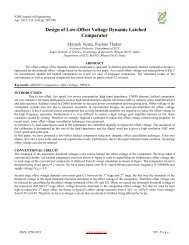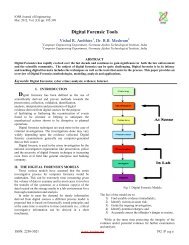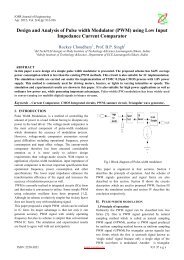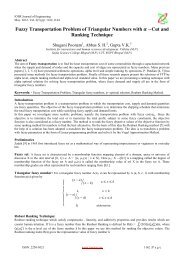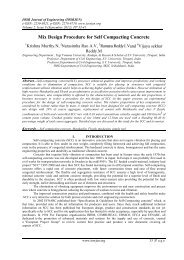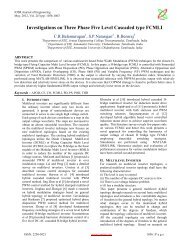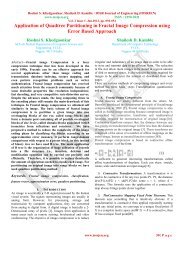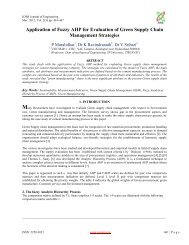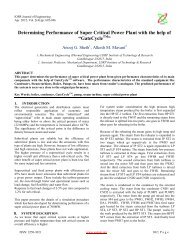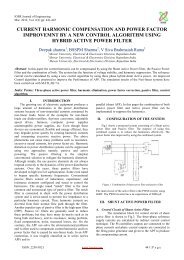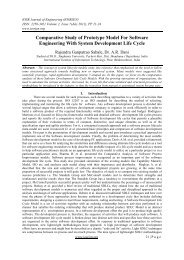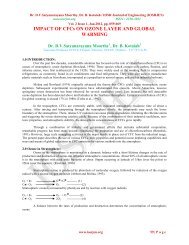Effect of Noise on image steganography based on LSB ... - IOSRJEN
Effect of Noise on image steganography based on LSB ... - IOSRJEN
Effect of Noise on image steganography based on LSB ... - IOSRJEN
You also want an ePaper? Increase the reach of your titles
YUMPU automatically turns print PDFs into web optimized ePapers that Google loves.
IOSR Journal <str<strong>on</strong>g>of</str<strong>on</strong>g> Engineering<br />
Mar. 2012, Vol. 2(3) pp: 473-477<br />
RSA a secret algorithm; our applicati<strong>on</strong> follows the secure<br />
programming principle <str<strong>on</strong>g>of</str<strong>on</strong>g> open design. To combat<br />
steganalysis, our applicati<strong>on</strong> performs an analysis <strong>on</strong> the<br />
user‟s library <str<strong>on</strong>g>of</str<strong>on</strong>g> <strong>image</strong>s. This analysis allows users to hide<br />
their data in the <strong>image</strong> that is least likely to be vulnerable to<br />
steganalysis.In this paper also simulates the rec<strong>on</strong>structi<strong>on</strong><br />
performance <str<strong>on</strong>g>of</str<strong>on</strong>g> stego <strong>image</strong> at receiver when these <strong>image</strong>s are<br />
transmitted through AWGN channel.<br />
II. RELAT ED WORK<br />
There are many <strong>steganography</strong> tools which are capable <str<strong>on</strong>g>of</str<strong>on</strong>g><br />
hiding data within an <strong>image</strong>. These tools can be classified into<br />
five categories <strong>based</strong> <strong>on</strong> their algorithms: (1) spatial domain<br />
<strong>based</strong> tools; (2) transform domain <strong>based</strong> tools; (3) document<br />
<strong>based</strong> tools; (4) file structure <strong>based</strong> tools; and (5) other<br />
categories such as video compress encoding and spread<br />
spectrum technique <strong>based</strong> tools [2]. The spatial domain <strong>based</strong><br />
<strong>steganography</strong> tools use either the <strong>LSB</strong> or Bit Plane<br />
Complexity Segmentati<strong>on</strong> (BPCS) algorithm. The <strong>LSB</strong><br />
algorithm uses either a sequential or scattered embedding<br />
schemes for hiding the message bits in the <strong>image</strong>. In the<br />
sequential embedding scheme, the <strong>LSB</strong>s <str<strong>on</strong>g>of</str<strong>on</strong>g> the <strong>image</strong> are<br />
replaced by the message bit sequentially (i.e. <strong>on</strong>e by <strong>on</strong>e in<br />
order, as menti<strong>on</strong>ed in the introducti<strong>on</strong>). In the scattered<br />
embedding scheme, the message bits are randomly scattered<br />
throughout the whole <strong>image</strong> using a random sequence to<br />
c<strong>on</strong>trol the embedding sequence. Two basic types <str<strong>on</strong>g>of</str<strong>on</strong>g> <strong>LSB</strong><br />
modificati<strong>on</strong>s can be used for the embedding schemes<br />
described above. They are <strong>LSB</strong> replacement and <strong>LSB</strong><br />
matching. In <strong>LSB</strong> replacement, the <strong>LSB</strong> <str<strong>on</strong>g>of</str<strong>on</strong>g> the carrier is<br />
replaced by the message bit directly. On the other hand, in<br />
<strong>LSB</strong> matching if the <strong>LSB</strong> <str<strong>on</strong>g>of</str<strong>on</strong>g> the cover pixel is the same as the<br />
message bit, then it remains unchanged;<br />
Otherwise, it is randomly incremented or decremented by <strong>on</strong>e.<br />
This technique, however, requires both the sender and the<br />
receiver to have the same original <strong>image</strong>, which makes <strong>LSB</strong><br />
matching very inc<strong>on</strong>venient [2]. The current Steganography<br />
tools <strong>based</strong> <strong>on</strong> the <strong>LSB</strong> algorithms include S-Tools, Hide and<br />
Seek, Hide4PGP and Secure Engine Pr<str<strong>on</strong>g>of</str<strong>on</strong>g>essi<strong>on</strong>al. These tools<br />
support BMP, GIF, PNG <strong>image</strong>s and WAV audio files as the<br />
carriers [2]. Each <str<strong>on</strong>g>of</str<strong>on</strong>g> these tools has unique features. S-Tools<br />
reduce the number <str<strong>on</strong>g>of</str<strong>on</strong>g> colors in the <strong>image</strong> to <strong>on</strong>ly 32 colors.<br />
Hide and Seek makes all the palette entries divisible by four.<br />
In additi<strong>on</strong>, it forces the <strong>image</strong>s sizes to be 320x200, 320x400,<br />
320x480, 640x400 or 1024x768 pixels.Hide4PGP embeds the<br />
message in every <strong>LSB</strong> <str<strong>on</strong>g>of</str<strong>on</strong>g> an 8-bit BMP <strong>image</strong>s, and in every<br />
fourth <strong>LSB</strong> <str<strong>on</strong>g>of</str<strong>on</strong>g> a 24- bit BMP <strong>image</strong>. These applicati<strong>on</strong>s are<br />
flawed because they do not analyze the <strong>image</strong> file after it has<br />
been embedded with data to<br />
see how vulnerable it is to steganalysis. The transform domain<br />
<strong>based</strong> <strong>steganography</strong> tools embed the message in the transform<br />
coefficients <str<strong>on</strong>g>of</str<strong>on</strong>g> the <strong>image</strong>. The main transform domain<br />
algorithm is JSteg [2].These applicati<strong>on</strong>s can <strong>on</strong>ly work with<br />
JPGs because most other <strong>image</strong> formats do not perform<br />
transforms <strong>on</strong> their data. The document <strong>based</strong> <strong>steganography</strong><br />
tools embed the secret<br />
message in document files by adding tabs or spaces to .txt or<br />
.doc files [2]. These applicati<strong>on</strong>s are limited because they <strong>on</strong>ly<br />
work with document files. They also cannot hide much data<br />
because there are a very limited number <str<strong>on</strong>g>of</str<strong>on</strong>g> tabs or spaces they<br />
can reas<strong>on</strong>ably be added to a document. In additi<strong>on</strong>, they are<br />
vulnerable to steganalysis because it is easy for an attacker to<br />
notice a document file that has been embedded with additi<strong>on</strong>al<br />
tabs or spaces. The file structure <strong>based</strong> <strong>steganography</strong> tools<br />
embed the secret message in the redundant bits <str<strong>on</strong>g>of</str<strong>on</strong>g> a cover file<br />
such as the reserved bits in the file header or the marker<br />
segments in the file format [2]. These applicati<strong>on</strong>s cannot hide<br />
very large data files because there are a very limited number<br />
<str<strong>on</strong>g>of</str<strong>on</strong>g> header or marker segments available for embedding hidden<br />
data.<br />
There are also <strong>steganography</strong> tools <strong>based</strong> <strong>on</strong> video<br />
compressi<strong>on</strong> and spread spectrum techniques. The large size<br />
Of video files provides more usable space for hiding <str<strong>on</strong>g>of</str<strong>on</strong>g> the<br />
message. The spread spectrum technique spreads the energy <str<strong>on</strong>g>of</str<strong>on</strong>g><br />
embedded message to a wide frequency band, making the<br />
hidden message difficult to detect [2]. These <strong>steganography</strong><br />
tools are inc<strong>on</strong>venient because they require the users to send<br />
an entire video file every time they want to send hidden data.<br />
III LEAST SIGNIFICANT BIT INSERTION METHOD<br />
Least significant bit inserti<strong>on</strong> is a comm<strong>on</strong>, simple approach to<br />
embed informati<strong>on</strong> in a cover file [3]. Usually, three bits from<br />
each pixel can be stored to hide an <strong>image</strong> in the <strong>LSB</strong>s <str<strong>on</strong>g>of</str<strong>on</strong>g> each<br />
byte <str<strong>on</strong>g>of</str<strong>on</strong>g> a 24-bit <strong>image</strong>. The resulting stego-<strong>image</strong> will be<br />
displayed indistinguishable to the cover <strong>image</strong> in human visual<br />
system [4].<br />
Fig. 2: Least Significant Bit<br />
The last bit <str<strong>on</strong>g>of</str<strong>on</strong>g> the byte is selected as least significant bit in <strong>on</strong>e<br />
bit <strong>LSB</strong> as illustrated in Figure 2 because <str<strong>on</strong>g>of</str<strong>on</strong>g> the impact <str<strong>on</strong>g>of</str<strong>on</strong>g> the<br />
bit to the minimum degradati<strong>on</strong> <str<strong>on</strong>g>of</str<strong>on</strong>g> <strong>image</strong>s [5]. The last bit or<br />
also known as right-most bit is selected as least significant bit,<br />
due to the c<strong>on</strong>venti<strong>on</strong> in positi<strong>on</strong>al notati<strong>on</strong> <str<strong>on</strong>g>of</str<strong>on</strong>g> writing less<br />
significant digit further to the right [6]. In bit additi<strong>on</strong>, the<br />
least significant bit has the useful property <str<strong>on</strong>g>of</str<strong>on</strong>g> changing rapidly<br />
if the number changes slightly. For example, if 1 (binary<br />
00000001) is added to 3 (binary00000011), the result will be 4<br />
(binary 00000100) and three <str<strong>on</strong>g>of</str<strong>on</strong>g> the least significant bits will<br />
change (011 to 100).<br />
ISSN: 2250-3021 www.iosrjen.org 474 | P a g e



